Executive Summary
With the ongoing commoditization of investment management services, and ever-increasing pressure on active investment managers to demonstrate their value, many have raised the question of whether financial advisors will eventually succumb to the pricing pressures of low-cost robo-advisors.
In today's guest post, Bob Seawright from Above The Market makes a compelling case for the long-term value of a financial advisor beyond just security selection and portfolio management, and highlights a "hierarchy of financial advisor value" that starts with the areas where financial advisors have the most impact - on savings and investment behavior, and providing financial planning advice - beyond which the actual implementation of an investment portfolio is just a small slice.
So whether you're a financial advisor who finds it difficult to articulate your value beyond just portfolio management services, or are simply looking for a new take and some fresh inspiration on how to describe your value to current and prospective clients, I hope that you find this hierarchy of financial advisor value to be beneficial in your practice!
I talk often with lots of advisors of all sorts and from a wide variety of firms. They are profoundly disillusioned an astonishingly high amount of the time. When the markets are strong, they are disappointed that they didn’t capture enough of the upside. When the markets are weak, they are apoplectic that they didn’t avoid the downturn. When markets are sideways, they’re just plain frustrated. When they try to anticipate these movements they usually fail and when they don’t – a very rare event indeed – their next moves inevitably don’t keep up the good work. They hate seeming to start from scratch every day and living from transaction to transaction, dependent upon the machinations of markets for survival.
Advisor Disillusionment: Execution, Expectation And Erroneous Priorities
This profound disillusionment is well-earned, of course, and is predicated upon three primary problem areas: execution; expectation; and erroneous priorities. The basis for each of these problems can be established in surprisingly short order.
In terms of execution, the trade ideas they offer rarely turn out well and the performance provided by money managers, when they go that route, almost never meet expectations such that it’s not unfair to say that much of the money management business has been an abject failure pretty much across-the-board, even for the mega-rich. Poor investor behavior makes that dreadful performance even worse — we trade too often, at the wrong times and into the wrong instruments. We chase returns via managers, sectors and trades that have been hot only to be disappointed when mean reversion inevitably sets in. Our inflated expectations make matters worse still because investors expect outperformance as a matter of course and investment managers tell them to expect it, implicitly and explicitly. That’s what makes the sale after all.
Erroneous priorities include a failure to manage to personal needs, goals and risk tolerances as well as “plans” that change with every market movement. It shouldn’t surprise anyone that clients with huge appetites and tolerance for risk when markets are rallying frequently want to go to cash at the first sign of trouble. At the advisor level, the priority problem is even more fundamental and encompasses each of these problem areas. Much of what tries to pass as “financial advice” is actually glorified (or even not-so-glorified) stock-picking. In my experience, most advisors and their clients wrongly think that the advisor’s primary function is to pick good investment vehicles.
Advisors are well aware of the failures of the money management business, of course, as well as the limitations of a transactional business model. That’s a big reason why their disillusionment is so existential. They have been let down again and again by the idea that they have (finally!) come up with a formula for success only for reality to crush those promises. Even worse, and consistent with that conundrum, a 2012 study from the National Bureau of Economic Research concluded that financial advisors reinforce behavioral biases and misconceptions – the problems outlined above – in ways that serve the advisors’ interests rather than those of their clients.
Still, many of these advisors keep hoping against hope. They routinely tell me that if they proposed a data-driven, evidence-based approach with their clients that actually had a reasonable chance for success, their clients wouldn’t perceive a need their services. Not so coincidentally, that’s a big reason why so many advisors are terrified by the proposed Department of Labor fiduciary rule with respect to retirement accounts. And that’s why the Dilbert cartoon reproduced below about index funds (one possible data-driven approach but hardly the only one) is so wickedly funny.

Proper advisor priorities begin with a recognition of what is important and what is achievable. That’s why I have created this hierarchy of advisor value, which was developed for a presentation I have been giving to groups of advisors.
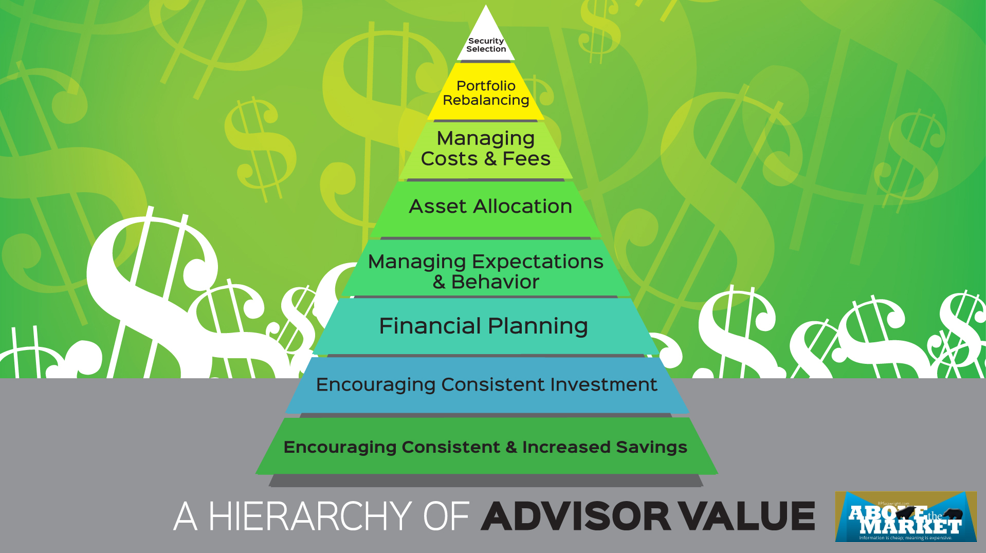
Managing to this hierarchy won’t make the markets any less infuriating, but doing so will make the financial advice business much more fulfilling and gratifying. It can even make that business more lucrative, at least over the longer-term. Simply put, it will require carefully and truly putting the client’s interests first, even when the client doesn’t see it that way.
Who Are Comprehensive Planners And What Do They Do?
Obviously, mine is not the first attempt to look at the advisor value equation. The NBER study referenced above, which found little advisor value, significantly did not consider advisors who actually work as comprehensive financial planners or investment managers acting as fiduciaries and did not control for the quality of advisor. That shouldn’t be all that surprising because, for most of its history, the financial services industry has been a sales industry dominated by individual transactions.
But not all financial advisors are transactional salespeople (and there are fewer of them every day). For example, an academic study that sought to examine the differences in outcomes for clients working with comprehensive planners and those working with transactional salespeople found decidedly in favor of the comprehensive planner. Of course, that distinction can be difficult to isolate. Still, the conclusion is clear: comprehensive planners help clients achieve improved financial outcomes.
A Morningstar study took a somewhat different approach but reached a consistent conclusion. Rather than attempting to measure the influence of actual financial advisors, the Morningstar study aimed to quantify the potential value provided by better financial decision-making – what the study calls gamma* and what Vanguard (see below) callsadvisor alpha – within the context of retirement income planning. According to the Morningstar study, a good advisor can add the equivalent of a 1.82 percent annual arithmetic return to clients through five specific components (listed below in decreasing order of impact).
- Dynamic withdrawal spending;
- Tax efficiency via asset location and withdrawal sourcing;
- Total wealth asset allocation (which includes human capital and Social Security planning);
- Adding guaranteed income efficiently; and
- Asset allocation based upon future spending needs and liability-matching.
Not surprisingly, the study found that making smarter financial decisions leads to better outcomes. More specifically, on a utility-adjusted basis, better planning allows for an increase in retirement income of 29 percent. Moreover (and significantly), one of study authors readily acknowledges that there are other sources of value, including estate planning, risk management and other forms of financial planning.
As Wade Pfau puts it, accurately and succinctly, “Financial advisors who only focus on selecting investments will really struggle to add value.” On the other hand, “there is immense value in comprehensive financial planning and good financial decision-making. It’s important to remember and easy to forget that the end goal of comprehensive financial planning goes beyond choosing investments.”
Vanguard has been looking at this subject since at least 2001. In summary (though I encourage you to read the entire report), Vanguard sees “advisor alpha” (summarized graphically here) as being built upon “the best practices of wealth management” and as having a potential value of roughly four percent per annum (before fees, which are presumed to be about one percent annually). Vanguard separates these best practices into three general categories.
- Portfolio construction;
- Behavioral coaching; and
- Wealth management.
In general, “[t]he potential benefits of using a financial planner include increasing wealth, protecting wealth, and smoothing consumption.” These categories are further broken down, of course, but you get the gist. My point here is not to try to quantify the value advisors provide with any specificity, but rather to point to the areas where they can make a difference and encourage advisors with the knowledge that they can and do create real value for their clients. Picking stocks or investment vehicles is a dying business. But comprehensive financial planning meets a great need and provides a real service.
Encouraging Consistent And Increased Savings
Over 60 percent of Americans have less than $1,000 in a savings account. Over 20 percent of Americans don’t even have a savings account and nearly 30 percent don’t have an emergency fund. Still, people are getting a bit better about saving for retirement. The average total contributions to 401(k) plans now tops $10,000. But it still isn’t sufficient. Many young workers are putting off saving until they’re older and (presumably) making more money, a mistake that mitigates the tremendous power of compound interest and which requires them to save much more later on just to catch-up. At the simplest level, the average worker saves just 8 percent of pay in a 401(k) plan. That isn’t nearly enough. One’s savings rate is far more important than his or her rate of return in determining how bright the future is likely to be. However, we are far more likely to obsess over squeaking out a bit more performance out of our investments or tweaking our asset allocation to increase or expected return rather than thinking about ways to save more. Good planning starts with putting the client’s financial house in order and making sure that a good savings plan is in place with the proceeds invested into a solid, diversified portfolio.
Encouraging Consistent Investment
Out of our general fear, even if and when we invest, we often don’t stay invested. But volatility — drawdown risk, really — is the price we pay for the higher expected returns provided by equities.
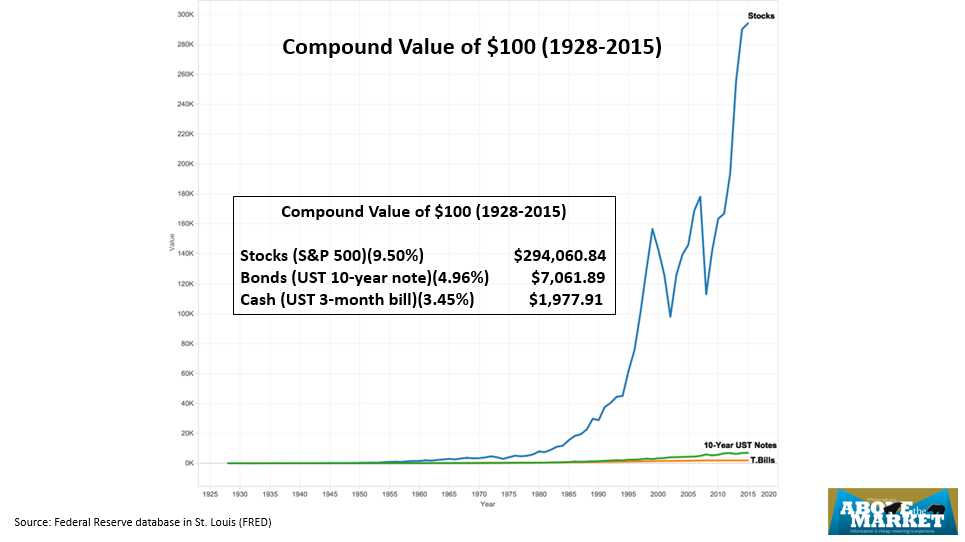
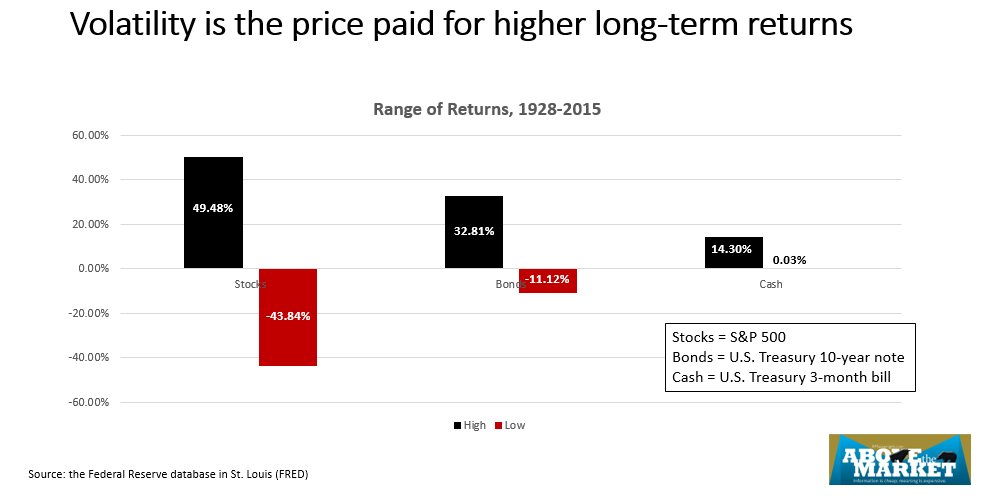
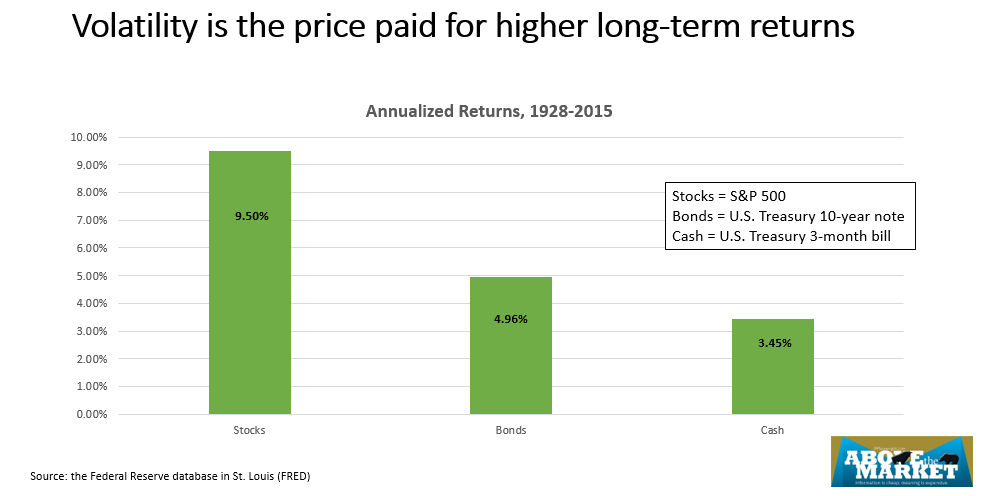
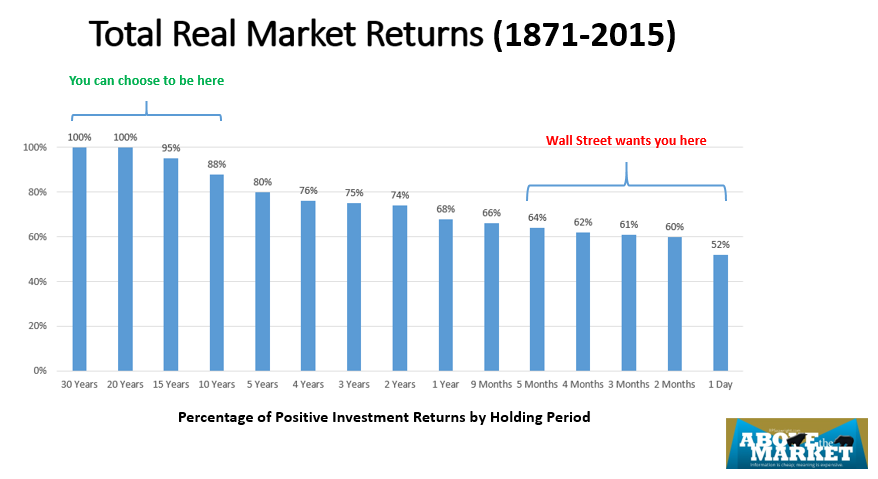
The above charts demonstrate that if we have the wherewithal to keep our composure during difficult markets, we will almost surely be rewarded for it.**
According to economist Tim Duy, “As long as people have babies, capital depreciates, technology evolves, and tastes and preferences change, there is a powerful underlying impetus for growth that is almost certain to reveal itself in any reasonably well-managed economy.” Numerous studies have shown that those who trade the most earn the lowest returns. Remember Pascal’s wisdom: “All man’s miseries derive from not being able to sit in a quiet room alone.” Overtrading is indeed a big killer of returns. As finance researchers Brad Barber and Terry Odean show in a landmark 2000 paper, “trading is hazardous to your wealth.” Yet our instinctive reaction to every market correction or downturn is to change something and almost always to sell something.
As David Rosenberg explains, “Corrections are part and parcel of the investment process, they come and go, and it is imperative to take a deep breath and realize that what is most important for building wealth is not ‘timing’ the market but rather ‘time in’ the market.” It pays to stay invested. So please listen to Wesley Gray: “You can lead an investor to a winning strategy, but you can’t make them stick with it when the going gets tough. Unfortunately, success comes at a steep price. You need to be willing to sit through periods of downright dreadful performance. No risk, no reward. It really is that simple.” Volatility (drawdown risk) is the price we pay for the higher expected returns provided by equities.
Financial Planning
In my experience, individual investors have a great deal of trouble establishing appropriate, realistic and manageable goals. Often they don’t even know what they should be concerned with or what they should include as part of a list outlining what they want or need to accomplish. A good advisor will.
Moreover, good comprehensive financial planning is imperative for good financial health. Yet consumers often mistake investment management with financial planning. Financial planning is much broader, involving far more than the managing of investments. It involves budgeting, goals, appropriate insurance, comprehensive planning for lifestyle, retirement and legacy, Social Security planning, broad and granular risk management, asset location and withdrawal planning, tax efficiency, tax planning and more. It also involves crisis prevention and management. Great investment management can be undone in a hurry by poor financial planning. A good advisor – a good financial planner (as Michael Kitces points out) – can work to help individuals formulate, monitor, adjust and meet their personal and financial goals. Real expertise is required to do so.
Another crucial thing a good financial planner can do is to help to protect aging clients from the impact of inevitable cognitive decline. Research confirms what most of us have seen among our families and friends. The ability to make effective financial decisions declines with age. Thus those age 60 and up unnecessarily lose nearly $3 billion to fraud annually. To put it starkly, research shows that financial literacy declines by about 2 percent each year after age 60. Despite that decline, our self-confidence in our financial abilities remains undiminished (or even increases) as we age. That’s a scary combination that a good advisor can guard against.
Ultimately, a good advisor can and will influence and even change client behavior. In a world where personal financial issues have become increasingly and often unnecessarily complex, a good advisor can help clients figure out what is true and what isn’t, what works, what matters, what is useful, and what can go wrong. There are few enough people with the expertise sufficient to begin to do that for themselves. Nobody can do it objectively. That’s why good advisors are an absolute necessity.
Managing Expectations And Behavior
We are all prone to behavioral and cognitive biases that impede our progress and inhibit our success. We are prone to flitting hither and yon chasing after the next new thing, idea, strategy or shiny object. Our behavior typically corresponds to the following chart.
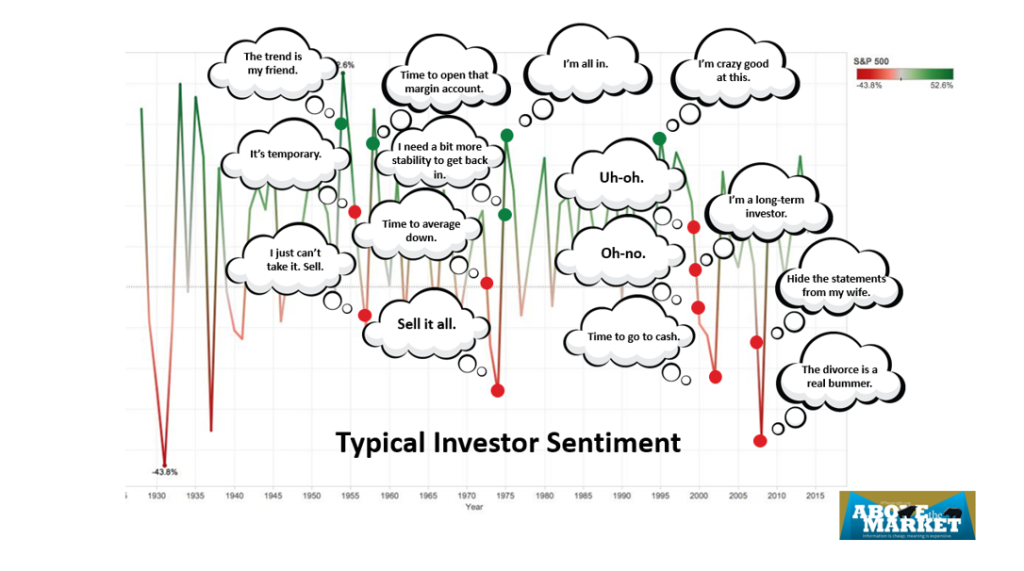
A good advisor can mitigate these tendencies. Doing so is vital, not the least of all because we tend to disbelieve that we are susceptible to them.
To put a finer point on it, there is a clear “behavior gap” between the average investor (money-weighted) return and the average investment (time-weighted) return that shows up consistently in the data, albeit in varying amounts. Thus there is some debate over whether the size of this performance gap could be overstated in certain studies due to the return calculation methods used or the pattern of returns over the time period analyzed. But irrespective of the particulars, it remains clear that the behavior gap is significant and the result of self-destructive investor behavior — most prominently panicking during market downturns and performance chasing.
Some research suggests that investors make mistakes by considering new opportunities in isolation, without fully accounting for how the decision will affect the overall health and performance of their portfolio. Other research shows that investors often evaluate their performance too myopically. A portfolio without some holding that are doing poorly isn’t well-diversified. A broader perspective that emphasizes this reality should help to prevent self-destructive performance chasing.
Through 2014 (more recent data is not yet available), the average investor earned a 10-year return of 5.21 percent compared with a 5.75 percent return for the average fund. The “behavior gap” was thus 54 basis-points. Allocation funds saw a minimal behavior gap; U.S. equities saw a 98 basis-point gap; and the taxable bond gap was 69 basis-points. This number has shrunk significantly in recent years, surely as the result of the long-term, Fed-induced bull market. It isn’t hard to predict that the behavior gap will be wider once year-end 2015 numbers are in due to last year’s volatility. Indeed, the average behavior gap from the past calendar-ending five-year periods is 1.32 percent. That’s a much better indicator of the nature of the behavior gap over the longer-term because it includes more types of market conditions.
Significantly, the lowest-risk quartile of all funds had a positive behavior gap of 1.26 percent while the second quartile had a behavior gap of only 4 basis-points. On the other hand, the third-quartile suffered a behavior gap of 32 basis-points while the highest-risk quartile saw a performance gap of 1.32 percent. Investing in cheaper funds – not surprisingly – led to higher returns but it also led to a smaller behavior gap. The quartile of U.S. equity funds with the highest costs suffered a huge performance gap of 2.99 percent as compared with 1.19 percent for the cheapest quartile. Across all funds, the behavior gap was 80 basis-points for the cheapest quartile of funds and 1.79 percent for the most expensive.
As the great Benjamin Graham sagely warned, “Individuals who cannot master their emotions are ill-suited to profit from the investment process.” Good advice increases the likelihood of success tremendously.
Asset Allocation
The total return of any portfolio has three components, which may be positive or negative: (a) returns from overall market movement; (b) incremental returns due to asset allocation; and (c) returns due to market timing, security selection, and fees. The best research suggests that, in general, about three-quarters of a typical portfolio’s variation in returns comes from market movement (a), with the remaining portion split roughly evenly between (b) and (c). To the extent that research differs from that stated above, it concludes that asset allocation is more important and the elements that comprise (c) are less important and further concludes that (b) is far easier to accomplish effectively. Moreover, good asset allocation is crucial to matching one’s portfolio with one’s goals, needs, situations and risk parameters, all of which are subject to change. The exercise of allocating funds among various investment vehicles and asset classes is at the heart of investment management. Asset classes exhibit different market dynamics, and different interaction effects. Thus the allocation of money among asset classes and among investment vehicles within asset classes will have an enormous effect on the performance of an investment portfolio. A good advisor is vital to good asset allocation.
Managing Costs And Fees (And Incentives Too)
The leading factor in the success or failure of any investment is fees. In fact, the relationship between fees and performance is an inverse one. Every investor needs to count costs and a good advisor can do the necessary research to do that as effectively as possible. Multiple studies all also establish what we should already know. A manager with a significant ownership stake in his fund is much more likely to do well than one who doesn’t. A good advisor will look to see that every manager in a client’s portfolio has sufficient “skin in the game.”
Portfolio Rebalancing
Rebalancing among investment types, such as an equity portfolio, for example, will likely improve performance by taking advantage of mean reversion. Rebalancing acrossinvestment types (to return, for example, to a desired weighting of stocks and bonds) will likely lower overall return – without it the equity allocation will typically grow due to the higher risk premium – but will make sure one’s portfolio is consistent with one’s risk tolerance. There is no definitively best way to do this, but a good advisor will undertake to rebalance portfolios so as to be as cost-effective and tax efficient as possible.
Security Selection
Stock-picking may be dead, but various studies demonstrate that certain investment characteristics can and do outperform with persistence over time (even though they can and do underperform for significant periods). These include size (the small-cap premium), value, momentum, quality, low beta and (perhaps) concentration. By following competent advice, investors can and should be also to take advantage of these anomalies, any new ones discovered, and to exit those approaches that no longer persist. As more and more money is allocated to so-called “smart beta” strategies, lack of persistence will become more and more of a concern and seemingly “tried and true” investment strategies will suffer unknown outcomes. A good advisor will stay on top of these trends and make sure that client portfolios continue to comport with the best research as well as client needs, goals and situations.
Conclusion
As I have noted before, American virologist David Baltimore, who won the Nobel Prize for Medicine in 1975 for his work on the genetic mechanisms of viruses, once told me that over the years (and especially while he was president of CalTech) he received many manuscripts claiming to have solved some great scientific problem or to have overthrown the existing scientific paradigm to provide some grand theory of everything. Most prominent scientists have drawers full of similar submissions, almost always from people who work alone and outside of the scientific community. Unfortunately, none of these offerings has done anything remotely close to what was claimed, and Dr. Baltimore offered some fascinating insight into why he thinks that’s so. At its best, he noted, good science is a collaborative, community effort. On the other hand, crackpots work alone.
That’s so because even when we readily spot the problems of others, we rarely see our own. In the immortal words of Pogo, we have met the enemy and he is us. We all suffer from bias blindness. Nobel laureate Daniel Kahneman’s seminal book, Thinking Fast and Slow, begins as follows: “The premise of this book is that it is easier to recognize other people’s mistakes than your own.” Whether we’re talking about Lennon and McCartney or Warren Buffett and Charlie Munger, we all tend to work better with help, advice, support, correction, criticism and accountability.
A smart investor looks for what can be done that offers the greatest opportunity for success in the markets. A smart person looks for what can offer the highest likelihood of meeting his or her needs, goals and desires. But finding and implementing the best ideas for doing so is deceptively easy conceptually but monumentally difficult to put into practice. Accordingly, good financial advice is both invaluable and rare. It requires far more than selecting investments. It requires substantial expertise and the ability to manage emotions and expectations. We shouldn’t ever be afraid of saying so and we should never shy away from providing the kinds of service that will demonstrate it beyond doubt. Good advisors add value — and a lot of it.
* This usage is confusing because academic finance already defines gamma as the rate of change for delta with respect to the underlying asset’s price. It is an important measure of the convexity of a derivative’s value, in relation to the underlying.
** More recent efforts to deal with volatility differently haven’t fared very well. For the period of 1998-2015 (the longest period available), alternative investments (represented by the HFRX Global Hedge Fund Index) have provided an average return of just 5.11 percent, with most of the better returns early in that period. For the period of 2004-2015 (the longest period available), fixed index annuities (represented by the American Equity Bonus Gold) have provided an average annual return of 4.15 percent, albeit with principal protection and a means to guaranteed lifetime income.





A candide perspective and practical prescription. His Hierarchy of Advisor Value is a work of art.
I am a young guy, and a young planner and this post affirms that I stumbled into doing it the right way.
I have been a fee-based comprehensive planner for the past 20 years. Our business model is exactly as described in the article. We have “outsourced” investment management because I never wanted my client relationships based on whether they made or lost money on any particular day. Because what we do is abstract, I have found it to be challenging at times to articulate my value. This article has brought it all full circle for me. I love the pyramid and plan on using something very similar to that to reinforce what we do and give clients the comfort to know they are “getting their moneys worth”. THANK YOU so much for this extremely valuable article!!
The hierarchy is wonderful, and should be shown to clients and prospective clients so that they understand what we are about.
BTW, just when you think you have categorized all the financial planning areas, e.g. debt management, insurance protection, etc., etc., etc., and new one comes along that doesn’t fit into a category. For example, was Social Security Maximization on your radar screen 10 years ago?
And perhaps good financial planners should also let our clients know that, “No one knows your future, but we will be there with you when it arrives.”
If “The leading factor in the success or failure of any investment is fees,” why is it so far from the base?
It’s sad to see “Encouraging Consistent & Increased Savings” as the main fundamental objective of an advisor. So, an advisor pushes his/her own agenda of convincing the client to delay the consumption for later… and, conveniently, that’s what the advisor’s fees are based on. I.e. “save & invest instead of consuming now… and let me make fees on that amount”.
The whole pyramid would be so much better without this hidden agenda! Yes, on average Americans may not be saving enough, but does it automatically justify the blanket recommendation of ‘consistent & increased savings’ for every person? This fundamental objective is wrong if there are at least some situations when ‘increased savings’ may not be optimal (see here: http://qr.ae/RglMv2).
Here’s the unbiased version of the fundamental advisor objective: help the client understand the trade off between consuming NOW (spending money today) and delaying consumption for later (saving for retirement), and let the client choose the right balance based on his/her life objectives and preferences.
With this approach, ‘decreased savings’ should also be an acceptable option if it fits the client’s life better.
Very good article. Thanks for sharing! Very good views shared on both sides. For more advise of your finance, visit us: http://yourcorner.com.au/